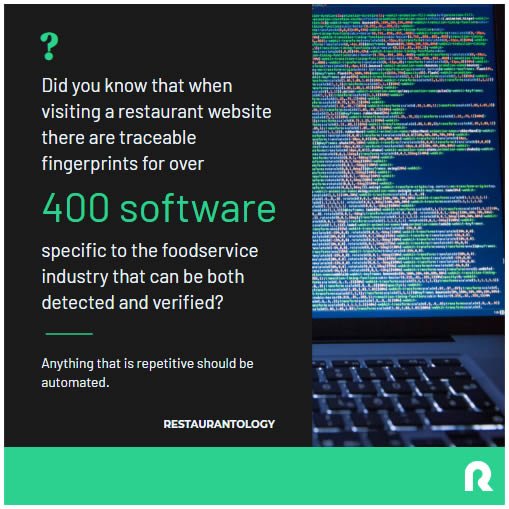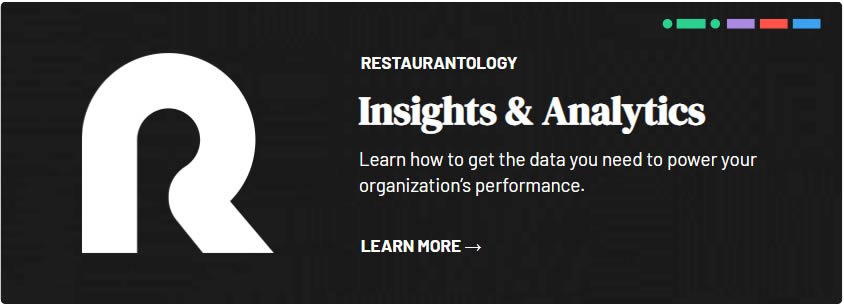4 reasons why your CRM’s restaurant data is terrible

Companies selling into the foodservice space, both big and small, have spent the better part of 2 decades battling bad restaurant data in their CRMs. And whether you like it or not, odds are your CRM has a bad data problem, too.
It’s officially February 2022, and for many companies the year began with 2021’s leftover frustration and contempt when logging into their CRMs for the millionth time. Everyone agrees that things would be easier if the data were better, but somehow data acquisition strategies never seem to make it into the budget. This is a big problem.
There are currently 4 “universal truths” when it comes to bad restaurant data
For years, the practice of finding and validating email addresses has been outsourced to third-party vendors like Zoominfo. Why? Because asking someone which specific emails are no longer valid in a database tens-of-thousands of entries long is unrealistic. And insane.
Why, then, do we allow the accuracy of dozens of dynamic CRM fields across thousands of records to rapidly depreciate in credibility over time? Unit counts, unit lists, trading areas, ownership hierarchies, tech stack info… One minute your data is updated, and moments later it’s way off. The old way isn’t working, and though the problem at hand often seems “too difficult” or “too time consuming to address,” you should never settle or become complacent with a problem that is, in fact, solvable.
Here are the 4 problems we believe exist for companies who sell into the foodservice industry:
- The restaurant industry is changing quickly
- The data you have is outdated or, at a minimum, incomplete
- Snapshot list purchases don’t work
- Humans cannot keep up with the rate of change
[01] The restaurant industry is changing quickly
Change is the only constant, or so we heard.
Fluctuations in unit counts in the restaurant industry aren’t anything new, though recent global events have certainly exacerbated these trends a bit. For decades, companies selling into the restaurant space have been plagued with bad CRM data for the simple fact that they cannot keep up with the rate of change in the industry. Over time, bad data leads to uncertainty, uncertainty leads to frustration, and frustration leads to… well, a lot of things.
Once thing is certain: the industry will continue to change, and rapidly. Thousands of new restaurants open across the US each month, and hundreds unfortunately close their doors. Unless you’re a master at Bayesian forecasting and can somehow tie your findings to your CRM, you’re left with two options when confronting your bad restaurant data: do nothing, or do something.
[02] The data you have is outdated or, at a minimum, incomplete
The “do nothing” option, all things considered, is bad for your business. I hope we can agree on that.
CRM data should be driving coverage models, solidifying territory definitions and chase lists, fueling micro-targeted marketing campaigns using firmographic and technographic details to customize a message that’s relevant to both your prospect and their business. It should be helping you understand where to invest, which partnerships could be the most lucrative, and which competitors are beginning to gain traction. And it should certainly be powering your post-sales teams (implementation, client success, and customer support), and providing your product team with the concrete insights they need to confidently align their roadmap to needs in the industry.
Basing strategic decisions off of something industry-specific like, for example, unit counts, while simultaneously leaving those fields to be updated “by hand,” is quite literally a bad data self-fulfilling prophecy. Similarly, if key qualification and discovery questions can be verified by simply visiting a prospect’s website, having blanks or bad data in the corresponding fields in your CRM is a huge opportunity for your business. Did you know that there are currently over 400 industry-specific software that can be detected by simply visiting a restaurant website?
Nowadays, savvy AEs can extract details like:
- Who are they using for food delivery?
- Do they offer mobile apps?
- Is there a loyalty program in place?
- Are they using their POS for online orders?
- Can you apply online?
- Can you purchase a gift card?
- Is there a reservation or waitlist widget?
- Do they collect emails for a newsletter or birthday dessert?
- Can you leave direct guest feedback about your latest experience?

This, of course, is just to name a few. The bar for what you consider to be your base-level restaurant dataset should likely be far higher than where it is right now. Dare to dream, right?
[03] Snapshot list purchases don’t work
For decades, the go-to method for the “do something about our bad data” crowd has been to find a qualified vendor who sells moment-in-time data via lists. Need contacts? Buy a list. Data stale or noisy? Purchase an update.
Oh, boy. Where do we start? Perhaps we should break down the following phrase:
Qualified vendors[1] who sell[2] moment-in-time data[3] via lists[4].
First, qualifying a vendor can be difficult. There are indeed a handful of reputable list-sellers that have been around for 20 to 30 years, but outside of the recognizable names it’s a legit free-for-all. Anyone selling you a list will be difficult to qualify, namely because the only 2 ways to verify a list purchase vendor — data quality (via samples) and references — can be easily fabricated. Buyer beware.
Second, it’s costly. Purchasing a massive list once a year, whether there are relevant changes or not, is wasteful. Many times you don’t have a choice in the matter, though, because companies selling lists for purchase often refuse to do additional work on their end to drive down the price to match your budget. Thus, you’re forced to purchase sweeping portions of an external database that you’re left on your own to make heads or tales of.
Third, there’s really no telling how up-to-date the data is. List vendors typically shy away from verification dates, much to the detriment (and chagrin) of the purchaser. Try imagining how valuable purchasing a list of old or unverified data is, and then try imagining how quickly it becomes even more out of date a month later. Painful, isn’t it?
Lastly, implementation of a CSV is rough. Once you have a list, say a quarterly snapshot export of a dataset, making it strategic or actionable often requires a manual import into your CRM. Is this an insert or an upsert? Am I creating duplicates? Will this data import lead to any data loss? Are there existing processes that will be triggered once we mass update certain fields? Are there downstream systems that are about to be inadvertently taken offline? Even if you’re lucky enough to have a dedicated Sales Ops resource, their Slack response to all this is probably just: 🤷. Separately, don’t be fooled by vendors who have beautiful online platforms that let you filter and export exponential numbers of data subsets. This is not in your best interest, but instead exponentially complicates your data acquisition strategy. Ugh.
[04] Humans cannot keep up with the rate of change
One final “do something about our bad data” strategy has been to task internal employees or external contractors with fixing the problem via brute force. This is difficult, this is tedious, and this is time consuming. And, imho, this is maddening.
As we mentioned previously, location counts change ad infinitum. We all know this. When units drop from 90 to 60 in a well-known restaurant concept, or when an up-and-coming brand jumps from 2 to 6 units in the same month, who in your organization is responsible for [1] knowing when this happens, and [2] documenting the change in the CRM? If your answer is “it’s the AE’s responsibility,” I hate to say it but you might be part of the bad data problem. Sales reps should not be responsible for this type of data entry.
We posit that there are currently north of 15,000 multi-unit, aka 2+physical location, restaurant concepts in the US and Canada. Similarly, we would argue that trying to keep up with the movement of 15k records is, quite literally, not possible with human beings when you consider the time and budget required to do so. All the Google alerts in the world couldn’t make this feasible.
Disagree? Think about it.
Even if you had a direct URL to the location page of a multi-unit restaurant concept, and even if you could open it, count the number of units, navigate to the record in the CRM and update it all within 60 seconds, it would take a human being 250+ hours to verify that single specific piece of firmographic information. And that’s leaving out the other 400+ industry-specific, detectable software aforementioned.
This is more work hours than there are in a month (~160), meaning if the goal was to verify this number, and only this number, each and every month to keep your CRM data clean, your worker would have to start over before even finishing. It’s just not possible. Or at a minimum, it’s not realistic. Not to mention your worker would likely go crazy before EOM.
Anything that is repetitive should be automated
By now, you’ve probably come to the same conclusion as we did back in 2017 when we founded Restaurantology:
“There needs to be a way to bridge the gap between publicly available restaurant data and our CRM, one which can automate updates to critical fields as the data inevitably changes over time.”
That’s the dream. Not lists that unfortunately never get uploaded or sales reps that have to manually update fields while mentally screaming into a pillow.
But what would a realistic solution even look like? Let’s go back to our phrase from earlier that captures the approach taken in the past:
Qualified vendors[1] who sell[2] moment-in-time data[3] via lists[4].
A more modern day version of this phrase, one that could really solve your CRM’s bad restaurant data problem once and for all, might look like this:
Proven vendors[1] who lease[2] near-real-time data[3] via integration[4].
Believe it or not, you’re already familiar with the concept. Zoominfo does this with contacts and emails. Now, Restaurantology is doing this for the foodservice industry.
Find a trusted partner and let them handle the hard part
First, you’ll need a vendor who can prove they do what they say they do with no ifs, ands, or buts. This is the easy part if you have an easy-to-use interface where end-users can browse your database to their heart’s content. This is precisely why we offer a Chrome extension, built with sales reps in mind, which gives anyone interested in learning more about the restaurant industry a “pocket dictionary” to confirm firmographic or technographic details in seconds. You shouldn’t need wizard-level Excel skills to pivot your way through an online industry dashboard, and honestly we all know most sales reps don’t have that tool in their toolbelt.
Second, important data should be leased, not sold. Data-as-a-Service, or DaaS, is a modern way to lease future updates to desired datasets in perpetuity. One-time snapshots are out, monthly automated updates are in. They’re the new black.
Third, data quality should never be unclear. We believe full transparency regarding the “when, where, how, and how often” data is being sourced is of the utmost importance when partnering with a data provider. A lack of confidence in the data is part of the current problem, and therefore should be no part of the hypothesized solution.
Lastly, it is unrealistic to expect thousands of data points to be managed via manual update or mass import on literally any timescale. What good is a list if it cannot be easily incorporated into your CRM? Solving your bad restaurant data problem means integrating automated updates in a meaningful way. No doubt it’s cliché, but Ron Popeil was right when he kept screaming, “set it and forget it.”
Find a partner with good data. Integrate it with your CRM. Walk away.
It really is just that easy. Or at least it can be.



